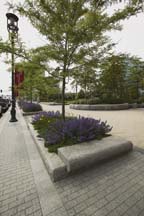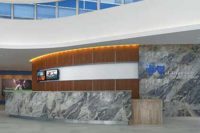
The South Boston Seaport District is being called the city's “first new neighborhood in more than 150 years.†The area has received a record-breaking $20 billion in public investment for infrastructure, which has transformed the little-known district and working port into one of the best development opportunities on the East Coast. New retail, dining and entertainment establishments continue to benefit from the dramatic growth in the seaport.
Polycor, the second largest supplier of natural stone in North America, supplied a large quantity of stone material for three major projects in the redevelopment.

Fortifying the “Big Digâ€
Stone from Polycor was used for the Broadway Bridge and the Fort Points Channel Sea Wall, both part of the “Big Dig,†a major transportation overhaul for the City of Boston. These two portions of the project cost nearly $2 billion. The contractors involved with the three phases of construction were Slattery Skanska, Modern Continental and a joint venture between Kiewit and Cashman.The Broadway Bridge is designed as a nine-span continuous structure that carries traffic over Amtrak tracks, a railroad yard and the Fort Points Channel. More than 90,000 square feet of Caledonia granite from Polycor was used for the walls, bridge piers, street and bridge curbs.
In all, more than 23,500 cubic feet of Caledonia was used for the Fort Points Channel Sea Wall. Modern Continental built the underwater and land tunnels connecting the Ted Williams Tunnel to the Massachusetts Turnpike. Some of the walls were newly constructed, and some were restorations.
For the newly constructed sea walls, which range from 15 to 25 feet high, the design used Caledonia as either veneer for appearance or as the actual structure of the wall.
“We are very pleased with the outcome of the project,†said John Capasso of Modern Continental. “So were the City of Boston and the architect.â€

Defining the landscape
The area is also home to the award-winning World Trade Center Complex. This 2.1-million-square-foot mixed-use complex includes two office buildings, the 426-room Seaport hotel/conference center and the 850,000-square-foot World Trade Center with office and convention space.More than 14,000 square feet of stone from Polycor was used to landscape the areas connecting these areas on the Trade Center complex. Additionally, approximately 4,500 square feet of stone from Polycor was used in the Trade Center building itself. The stone was installed by Kenneth Castellucci & Associates of Lincoln, RI, and the general contractor was Turner Construction.
“We used 3,700 cubic feet of Polycor original Caledonia for the landscaping of the World Trade Center,†said Jamie Crothers, the New England regional sales manager for Polycor. “The stone was used as decorative seat walls and stairs in the main garden area.â€
The unique color of the Caledonia granite played a major role in its specification, according to the landscape architects. “We used the Caledonia material because we find its dark color with a warm brown/bronze very appealing,†said Bob Uhlig, Principal and Project Manager with Halvorson Design Partnership, Inc., the landscape architects responsible for the entire site design. “The South Boston Waterfront has a tendency to have a lot of gray materials as an old industrial harbor area, and we chose to introduce warm hues in paving and granite components to make the area even more inviting and comfortable.â€
The design of the rock-pitched finished monolithic seat walls desired by Uhlig was a challenge for Polycor. “We used the rock-pitched finish to create a robust waterfront look in keeping with the harbor,†said Uhlig. “But it requires the stone return to the arris lines at each piece and where the stones meet finished grade, which is a challenge in the production but creates a very elegant result.â€
On Polycor's end, the difficult fabrication task was met using specialized stoneworking equipment. “We were able to meet this design challenge with Polycor radial guillotines,†explained Crothers.
Looking back at the project, the stonework achieved the architects' visions for the landscape. “We were thrilled with the attention to detail in the production of the granite on the project; it exhibits the versatility and enduring qualities of granite at its best,†Uhlig said. “The park is rich in waterfront materials and detailing that tell the story of the waterfront and provides a variety of landscaped 'rooms' that are comfortable for few or many people.â€

Providing a transition
In addition to characterizing many outdoor areas, the Caledonia granite also served as a transition material between the landscaping and the building itself. “Caledonia granite was used as the exterior base to the building to match its two earlier neighbors, previously constructed by our client,†said Theodore Szostkowski, AIA; design principal with Kallmann McKinnell & Wood Architects, Inc. “This selection visually connected the client's overall project.â€Polycor Granite Bussière supplied more than 20,000 square feet of stone for the building. Along with Caledonia, Ash Rose and Cambrian Black from Polycor were used as interior pavers, arranged in a striped pattern. “The primary field pattern was honed Ash Rose granite, selected for its compatibility with the painted window frame color and the exterior pre-cast pavers,†said Szostkowski. “The exterior pre-cast pattern and the interior stone pattern were intended to read as a continuous, uninterrupted field. Within the lobby, narrower stripes - alternately honed Cambrian Black granite and honed white marble - were added to create contrast and animation in the primarily gray field of color set by the Ash Rose.â€
Crothers said that he is very pleased to be a part of the revitalization and its ability to offer Bostonians a place to relax and enjoy the beautiful views of the waterfront. “I feel that a picture is worth a thousand words,†he said. “When you can see people casually enjoying the space in its desired use, this is a tribute to all involved.â€

